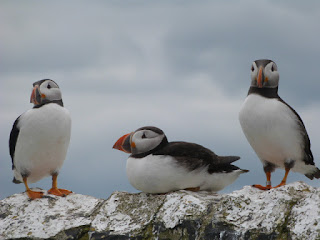At Campfield Marsh RSPB reserve Chris Spencer, an expert earth builder called Alex, some willing volunteers and some small children have been very busy building a clay dabbin vernacular style building that were once found on the Solway plains. Eventually the plan is to thatch the building with heather.
 |
| Clay bricks |
 |
| Chris very proudly showing us his clay dabbin building |
The materials used are pretty basic and not expensive, the first layer is turf which is laid on the frame grass side down.
The main material of course is heather which was harvested off the North York Moors and it only cost £15 a bale - bargain! We also used some hazel sways to hold the thatch in place.
William showed us how to tease the heather out of the bale and to arrange it into a bundle so that you ended up with the leaves at one end and the stalks at the other - or so that was the theory! The bundles were tied with twine and then we start on the bottom left corner to place them on the turf. A sway was stapled on using a screw and some wire - the unorganic material. We then hammered in stapples or spars with William's fantastic home made mallet to hold the heather in place.
And soon we had the first row finished and then it was just a case of adding more and more rows...
As the thatch got higher so did we, having to use a ladder to put our heather bundles in place. We then made a big roll or heather sausage to lay across the top a bit like a ridge pole!
The building has been continuing at Campfield Marsh and since my day thatching there has been Clay fest and the dabbin build is coming along nicely and is now almost finished. If you want to have a look for your self head down to RSPB Campfield Marsh and take a look at the amazing structure built by many willing workers!




































